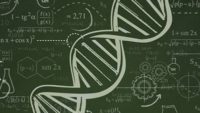By Dr. Andrew A. Snelling Geologists are uncovering evidence that meteors struck the earth throughout the Flood. Could they even have played a role in starting the Flood? …read more Source: AIG Daily
“I can’t picture a three-dimensional school of fish sinking to the bottom and maintaining all their relative positions,” said Dr. Plotnick, paleontologist at the University of Illinois at Chicago. “That makes no sense to me.”1 Dr. Plotnick was talking about a recent fascinating discovery of a fossilized school of extinct fish (an entire school—259 of them) discovered in Fukui P… More… …read more Source: icr.org
By Ken Ham I’m sure at some point you’ve heard the tired, old claim that humans and chimps are 98% similar or share 98% of their DNA. This claim is made in an attempt to prove the supposed evolutionary cousinship of humans and chimps. It’s made frequently, but that “fact” is anything but a fact—it’s simply not true. Dr. Georgia Purdom, a molecular geneticist, recently sat down with Pure Talk for an interview regarding creation, evolution, chimp and human DNA, and more. She brought her scientific expertise to bear on this question, among others. I encourage you to watch this [More]
Botanists have known for decades that plants aren’t just static entities that simply photosynthesize and reproduce. Indeed, plants read the living world around them with an incredible display of clearly designed sensory features that continues to amaze scientists.1-3 Plants read the living world … More… …read more Source: icr.org
By Ken Ham When you think of fungi, you probably don’t automatically think “smart”—especially considering they don’t have brains! But these incredible organisms are indeed “smart,” in the sense that they are designed to do what they do, and what they do, they do well. (Some of you may have heard me give a fun saying like this to kids in one of my live presentations!) The more we look at what God has made, the more obvious it is that we are without excuse if we refuse to acknowledge the Creator (Romans 1:20). And fungi are just one more [More]
“The greatest absence of evolution ever reported” is hailed as support for evolution. Read More
by Brian Thomas, Ph.D., and Timothy Clarey, Ph.D. Evolutionary narratives insist that kangaroos, and the marsupials they represent, evolved millions of years ago in Australia. Supposedly, that’s why today they only live there. In contrast, Genesis teaches that all animals—including kangaroos—migrated to their present locations from the Ark’s landing place “on the mountains of A… More… …read more Source: icr.org
By Jonathan Augusta The Creator made all creatures, including amoebas, with variation and plasticity in their genome for global differences of climate, terrain, and environment. …read more Source: AIG Daily
Modern science shows that Neandertals are fully human. …read more Source: creation.com
Travis T inquired about a recent article, which supposedly details how multi-celled animals could have developed. Dr Matthew Cserhati (CMI-US) responds. The experiment looks interesting, but it raises a lot of questions. A quote from the paper that you referenced: “The great-great-great-grandmother of all cells in the animal kingdom, so to speak, was probably quite similar to a stem cell.” Read More: Were stem cell-like organisms the first forms of life? – creation.com
Old World monkey and ape fossils both appear suddenly in the fossil record. (Note: “Old World” refers to countries known to Europeans before they discovered the Americas.) In 2013, the fossils were discovered together in an alleged 25 million-year-old Oligocene rock unit in Tanzania.1 Now a new alleged 22 million-year-old monkey fossil found in Kenya2 increases the known diversity for the sudden appearance … More… …read more Source: icr.org
Dolphins use ‘double sonar beam’ to narrow down prey’s location. Algorithm used to analyse this could help design better body scanners. …read more Source: creation.com
How did they form? …read more Source: creation.com
By Troy Lacey A new study in the journal Nature Medicine revealed a nasty downside to the mutant gene variant of CCR55, which prevents HIV infection. …read more Source: AIG Daily
By Melissa Webb Kids don’t just play differently from adults, they think differently too—by God’s design. …read more Source: AIG Daily
Long-age thinking held back scientific explanations of a major South African geological feature. …read more Source: creation.com
By Ken Ham A slab of limey shale features something incredible—259 fish, with scales, eyes, and fins—frozen as if in mid-swim. But how on earth is this possible? …read more Source: AIG Daily
Researchers have just reported a newly recoded bacterial genome in which genetic optimization was markedly reduced.1 Optimization is a principle of designed systems. Scientists hacked the bacteria’s genetic code and it experienced a huge reduction in growth. It also exhibited an abnormal cell shape. Despite this obvious detriment to the bacteria, the researchers gloated that life could still operate—a common, yet fail… More… …read more Source: icr.org
By Ken Ham A recent article from Fox News looked at five recent climate change warnings, and various experts weighed in on why these warnings were too over-the-top. …read more Source: AIG Daily
Scientists have concluded that our moon is probably still in the process of slightly shrinking as it cools.1,2 Photographs from the Lunar Reconnaissance Orbiter (LRO) showed embankments called scarps on the moon’s surface.3,4 These scarps are caused by a slight contraction of the moon’s crust as it cools. The moon’s cooling creates thrust faults which push up small sections o… More… …read more Source: icr.org
Answering a challenge to biblical geology: do pre-Ice Age ’tillites’ require glacial processes to form? …read more Source: creation.com
May 29 is World Digestive Health Day. The digestive system involves ten organs over nine meters of space, and contains over 20 specialized cell types. …read more Source: AIG Daily
Have you ever seen a dinosaur running in the rain? No, but a stunning new fossil find is the next best thing. …read more Source: creation.com
Electron microscope unlocks the amazing design of the structures that makes avian flight possible. …read more Source: creation.com
When were these geomorphological features carved? Read More
Perhaps the largest creature God created, this denizen of the deep is awesome to behold. Read More












































